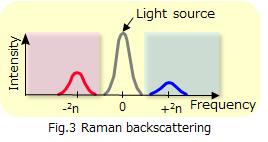"Early detection of failures in refractory materials"
Customer Concerns
Early detection of failures in refractory materials
Temperatures inside a harsh condition reactor such as synthesis gas reactor that produces carbon monoxide can reach as high as 1,600 degrees Celsius, and the outer surface of the reactor vessel can get as hot as 300 degrees Celsius. To protect their iron walls and enhance combustion efficiency, these facilities are lined on the inside with refractory bricks. As these bricks age and deteriorate, a variety of problems such as a drop in combustion efficiency and breaks in the iron wall can occur and result in the initiation of an emergency shutdown by the plant control system. In addition to being a safety issue, such unplanned shutdowns result in lost production and financial losses.

The Solutions and the Benefits
Quick detection of hot spots
Hot spots on the outer surface of a reactor or furnace occur wherever there are breaks in the refractory brick lining. With its optical fiber sensor cable, the Yokogawa DTSX distributed temperature sensor is able to constantly monitor for changes in the temperature of the outer wall and quickly spot problems early on, before they have a chance to grow into big problems and result in plant shutdowns or worse.
Proper maintenance period according to the conditions
Any reactor or furnace with a refractory brick lining needs to be shut down more frequently than other industrial facilities so that personnel can look inside and check the condition of the bricks. With the DTSX’s ability to monitor surface temperature 24/7/365, maintenance can be performed as soon as any signs are detected that indicate deterioration in the refractory liner. This switch to condition-based maintenance ensures that problems are caught early on and corrected.
How DTSX Works
Measuring the intensity of Raman scattered light
Using pulses of laser light beamed through an optical fiber cable, the DTSX is able to detect temperature-dependent variations in signal frequency that are the result of a phenomenon known as Raman scattering that occurs along the entire length of the optical fiber cable, and it also can determine the locations of those temperature readings using light that is bounced back (backscattering) to the source.
Example: Along a 6,000 meter optical fiber cable, nearly 6,000 measurement points
By measuring how long it takes light to make a round trip back to the source (backscattering), the DTSX is able to calculate the location for each temperature reading. Abnormalities can be located with a spatial resolution of just one meter.


Installation of the Optical Fiber Sensor Cable
There is no need to install a large number of temperature sensors. A single length of optical fiber sensor cable can be affixed to the surface of the reactor or furnace using aluminum tape or something similar. Figure 5 shows the layout of the optical fiber sensor cable on a reactor outer wall.

Looking for more information on our people, technology and solutions?
Contact UsGerelateerde Industrieën
-
Olie & gas
Yokogawa heeft diepgaande ervaring in elk deel van de olie- en gasindustrie. Van offshore- en onshore-installaties tot pijpleidingen, terminals en diepwateractiviteiten. Wij leveren oplossingen die de veiligheid verhogen, een nauwkeurige en betrouwbare werking garanderen en de efficiëntie van de installatie verhogen.
-
Downstream olie & gas
De downstream olie- en gasindustrie wordt de laatste jaren met een toenemend aantal uitdagingen geconfronteerd. Deze omvatten de veranderende kenmerken van de te verwerken grondstoffen, veroudering van procesinstallaties en apparatuur, stijgende energiekosten, gebrek aan geschoolde fabrieksoperators die een raffinaderij veilig en efficiënt kunnen leiden en de steeds veranderende eisen van zowel de markt als de klant.
In de loop der jaren is Yokogawa een samenwerkingsverband aangegaan met vele downstream bedrijven om industriële oplossingen te bieden die gericht zijn op het oplossen van deze uitdagingen en problemen. Yokogawa's oplossingen hebben plantmanagers geholpen om maximale winstgevendheid en duurzame veiligheid binnen hun fabrieken te realiseren.
-
Chemie
Chemische fabrieken zijn afhankelijk van continu- en batch-productieprocessen die elk verschillende eisen stellen aan een besturingssysteem. Een continu proces vereist een robuust en stabiel besturingssysteem dat niet faalt en de productielijn doet stilvallen. Bij een batchproces ligt de nadruk ligt op een besturingssysteem dat een grote flexibiliteit biedt bij het aanpassen van o.a. formules en procedures. Beide soorten systemen moeten worden beheerd naar aanleiding van de productiegeschiedenis rond de kwaliteit van het product, en in staat zijn om niet-routinematige werkzaamheden uit te voeren. Met een uitgebreide productportfolio, ervaren systeemingenieurs en wereldwijde verkoop- en servicenetwerk heeft Yokogawa een oplossing voor elk fabrieksproces.
-
IJzer en staal
In de ijzer- en staalindustrie is het van cruciaal belang om niet alleen de kwaliteit van producten te verbeteren, maar ook de productie- en bedrijfstechnologieën en om milieu- & energie-efficiëntievraagstukken aan te pakken. Yokogawa helpt klanten bij het creëren van de ideale fabriek en evolueert met hen mee voor wederzijdse groei.
Gerelateerde producten & oplossingen
-
DTSX1 Glasvezel Warmte Detector
DTSX1 slaat de functies die nodig zijn voor tochtdetectie op in één doos. DTSX1 analyseert de temperatuurgegevens met hoge nauwkeurigheid door te meten met glasvezelsensorkabel en voert hittedetectie bij hoge temperaturen uit. -
DTSX200 gedistribueerde temperatuursensor
De DTSX200 is een standaardversie die ideaal is voor temperatuurmeting, middelgrote gebieden en gebieden waar de afstand van glasvezelsensorkabels kort is. Het heeft een uitstekende omgevingsbestendigheid omdat het minder stroom verbruikt en minder afhankelijk is van de temperatuurmeetomgeving.
-
DTSX3000 Gedistribueerde temperatuursensor
De DTSX3000 is een gedistribueerde temperatuursensor die is ontwikkeld als antwoord op de vraag dat ‘één eenheid moet worden gebruikt om de temperatuurverdeling over een langere afstand en een groter gebied te bewaken’. Een topmodel dat voldoet aan de verwachtingen voor temperatuurmeting over lange afstand en hoge temperatuurresolutie.
-
Gedistribueerde temperatuursensor - Branddetectie/brandpreventie
Lange afstand, breed bereik temperatuurbewaking bereikt door de DTSX Fiber Optic gedistribueerde temperatuursensor Temperatuurbewaking over lange afstand en grote reikwijdte met de DTSX glasvezeltemperatuursensor